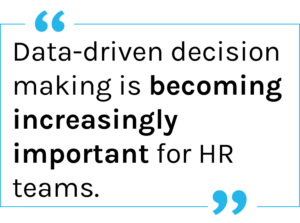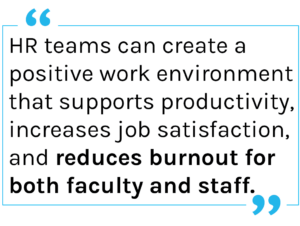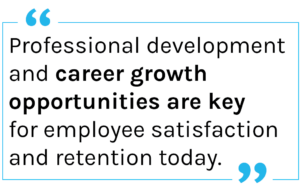The field of HR in higher education is evolving rapidly, driven by advancements in technology and changing expectations of employees.
Below, we’re exploring five ways HR is changing in HigherEd. From integrating technology into HR processes to embracing diversity and inclusion, these trends offer exciting opportunities for HR teams to innovate and meet the evolving needs of their workforce. Let’s dive in!
1: Integration of Technology in HR Processes
Integration of technology in HR processes is a rapidly emerging trend in HigherEd. By leveraging the power of technology, HR teams can streamline their processes and overcome challenges like manual data entry and inefficient communication. Implementing new technology also brings its own set of challenges, including resistance to change and ensuring data security. It is crucial for HR teams in higher education to carefully navigate these challenges in order to successfully digitize their campuses.
Benefits of Technology in HR Management
- Enhanced efficiency and productivity:
Automated systems streamline administrative tasks, allowing HR teams to focus on strategy instead of manual work. - Improved data accuracy and accessibility:
With less manual data entry, your team can reduce the risk of errors and duplicate information. Plus, cloud-based platforms (like PeopleAdmin’s HigherEd Cloud) provide easy access to information from anywhere at any time. - Streamlined recruitment and onboarding processes:
Technology simplifies the recruitment process by automating job postings, speeding up applicant screening, centralizing search committee processes, and digitizing onboarding, ensuring a seamless experience for new hires while saving time for hiring teams and managers.
Challenges of Implementing Technology in HR
Resistance to change among faculty and staff is often one of the key challenges for colleges and universities attempting to implement new HR systems. With the right tools for change management, however, you can guide your institution through the digital transformation. Check out our top tips for change management here.
Integration with existing systems and infrastructure can also pose a challenge for some institutions. Ensuring that the new technology seamlessly integrates with the organization’s current systems can be complex and time-consuming, requiring careful planning and coordination. Luckily, tools like PeopleAdmin’s Marketplace of Connectors offer seamless, out-of-the-box integrations with software already at play on your campus.
 2: Emphasis on Data-Driven Decision Making
2: Emphasis on Data-Driven Decision Making
In the ever-evolving landscape of higher education, data-driven decision making is becoming increasingly important for HR teams. By harnessing data analytics, HR professionals can gain valuable insights into employee performance, engagement levels, and overall organizational effectiveness, and leverage that information to enhance recruitment processes, optimize resource allocation, and improve employee satisfaction and retention rates.
The Importance of Data in HR Analytics
Utilizing predictive analytics for recruitment and retention can revolutionize HR practices in higher education. By analyzing data, HR teams can identify patterns and trends that help in making informed decisions about hiring the right candidates and keeping top talent engaged. For example, institutions can examine demographic information to pinpoint gaps in representation and create targeted strategies to promote equality within the workforce, helping further DE&I initiatives.
HR teams can also use data to better understand internal processes like professional development and performance management. By analyzing performance metrics and identifying skills gaps through comprehensive assessments, tailored training programs can be designed that address specific needs of each staff member. This approach ensures targeted growth opportunities that align with institutional goals while maximizing employee potential.
3: Focus on Employee Well-being and Work-Life Balance
Prioritizing mental health and wellness in the workplace has become a critical HR challenge in higher education. By implementing programs that support employee well-being, such as mindfulness sessions, work-life balance initiatives, or mental health resources, HR teams can create a positive work environment that supports productivity, increases job satisfaction, and reduces burnout for both faculty and staff.
programs that support employee well-being, such as mindfulness sessions, work-life balance initiatives, or mental health resources, HR teams can create a positive work environment that supports productivity, increases job satisfaction, and reduces burnout for both faculty and staff.
Addressing Mental Health and Wellness
Implementing mental health support programs can be an important step in addressing the well-being of higher education employees. By offering counseling services, workshops, and group therapy sessions, HR teams can provide the necessary resources for employees and students to manage their mental health effectively. By promoting a culture of well-being through open discussions about mental health and building a supportive community, HR teams can create an environment where individuals feel comfortable seeking help when needed.
Work-Life Balance Initiatives
HigherEd HR teams can take a big step towards reducing faculty and staff burnout by proactively creating work-life balance initiatives. A few good first steps include:
- Offering flexible or hybrid work arrangements.
- Encouraging time off to prevent burnout and promote employee well-being.
- Offering discounted childcare services to support working parents.
4: HR-Driven Continuous Learning
Continuous learning is also gaining traction in HigherEd, with a focus on providing employees with ongoing opportunities for career growth and professional development. Promoting a culture of learning increases employee engagement while equipping faculty and staff with new skills that align with evolving job requirements in the dynamic field of higher education.
 Promoting Continuous Learning and Development
Promoting Continuous Learning and Development
Professional development and career growth opportunities are key for employee satisfaction and retention today. HigherEd HR teams facing retention challenges can embrace a continuous learning mindset to encourage employees to pursue long-term careers at their institution.
Providing access to online learning platforms is one effective way to promote continuous learning and development. These platforms offer a wide range of courses and resources that employees can access at their own convenience, allowing them to expand their knowledge in specific areas or acquire new skills relevant to their roles. A centralized tool like PeopleAdmin’s Professional Development and Learning keeps all of your learning content in one place and helps build a community of growth on campus.
Establishing mentorship programs is another way to create space for continuous learning and development. Pairing experienced professionals with junior faculty or staff creates opportunities for sharing expertise, gaining insights, and encouraging personal growth. Mentorship programs can provide guidance for career advancement and professional goal-setting.
Final thoughts
HigherEd HR teams are facing some of their toughest challenges yet. Between rapidly-changing technology, hiring and retention challenges, and newly hybrid work environments, it can be hard to know what to tackle next. But with the right tools—like PeopleAdmin’s HigherEd Cloud—your institution can be technology-driven, dynamic, and employee-focused. HR teams can lead the way by championing change management, faculty and staff well-being, integrated technology, and continuous learning.